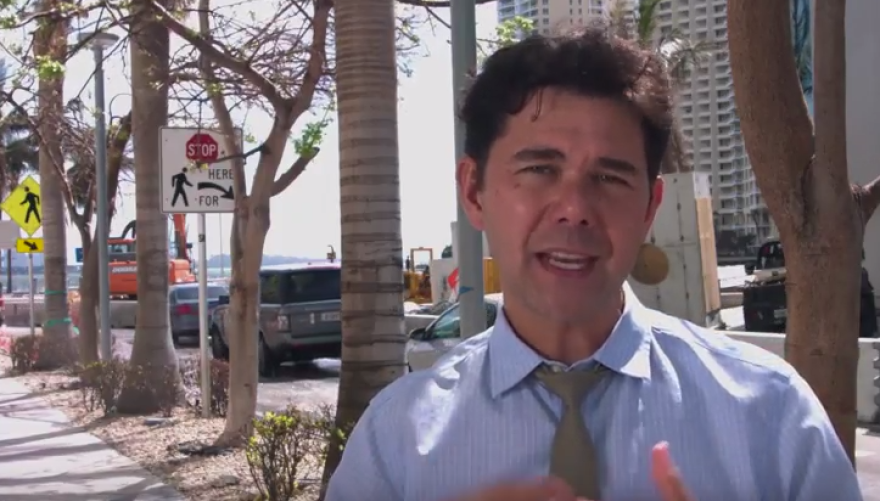When Miami voters head to the polls on Tuesday, they're going to find this question:
Shall the City issue General Obligation Bonds in an aggregate principal amount not exceeding $400,000,000.00 with interest payable at or below the maximum rate allowed by law, payable from ad valorem taxes levied on all taxable property in the City, provided that the capital projects debt millage not exceed the current rate of 0.5935, to: • Reduce Flooding Risks; Improve Stormwater Infrastructure; • Improve Affordable Housing, Economic Development, Parks, Cultural Facilities, Streets, and Infrastructure; • Enhance Public Safety?
The hapless voter must then decide whether he or she is "For Bonds" or "Against Bonds."
"Ad valorem taxes"? "Capital projects debt millage"?! Not to worry. Here's what's going on:
The city of Miami is asking voters to approve a bond issue to fund projects addressing sea level rise, high housing costs and other challenges to future livability. The bond would be worth $400 million, but that whole part about "debt millage not exceeding the current rate" means property taxes wouldn't increase to pay for it. (The city would be able to pull that off because it wouldn't take on new debt for this bond until it finishes paying off old debt on previous bonds.)
So: no new taxes, but the city still gets money to prepare for sea level rise and enhance public safety. That's a good deal, according to supporters like Mayor Tomás Regalado and District 2 Commissioner Ken Russell.

(You may have seen Russell and Regalado championing the bond in TV ads and online.)
But a "For Bonds" vote has implications beyond giving the city permission to spend $400 million on resilience projects.
Read more: Owed Back Pay, Miami Cops And Firefighters Attack Mayor's Bond Campaign
First, although taxes won't increase if the bond issue is approved, voters would lose out on the reduction in taxes they'd normally get when the city finishes paying off its old debt.
Second, the bond money would go to address specific types of problems (sea level rise, flooding, high housing costs, stormwater infrastructure etc.) but it's not yet entirely clear what projects within those categories would be funded. That's raising eyebrows even among some groups that work on sea level rise, affordability and climate-related issues.
The Miami Climate Alliance, for instance, is in favor of the bond issue, but with caveats.
The umbrella organization brings together climate and social justice groups to exchange information and collectively organize for events like the People's Climate March. Leaders wrote a letter to Mayor Regalado after some of the groups in the alliance expressed concern the bond funding wouldn't be equitably distributed to projects in lower income communities or communities of color.

"History has left us skeptical that the bond program will be implemented in an equitable fashion and without negative impacts to vulnerable populations," the leaders wrote. But "programs like these are necessary for local government to begin addressing issues that our most vulnerable populations face."
The leaders wrote that they "demand and expect" that community concerns drive where affordable housing dollars are spent, that funding for parks not exclude black and brown communities and that the project selection process be transparent. They are seeking a seat on the board of citizens that would review bond projects.
"The biggest, concerning part for a lot of residents and some organizations is the lack of specificity in projects, and how it's 'You just gotta trust us,' " said Maggie Fernandez, chair of the Climate Alliance's legislative and advocacy committee and president of Sustainable Miami, a climate justice consulting business. "So as the Miami Climate Alliance, we're trusting, but we want to make sure that the projects... truly are the projects where there's the most need."
Miami officials have provided a breakdown of how the $400 million would be spent: $192 million on sea level rise projects; $100 million for affordable housing; $78 million for parks and cultural facilities; $23 million for road improvements; and $7 million for public safety.

They say the public safety money would go toward a new fire station at 4101 NW Seventh Ave. in Liberty City. The rest of the money could go toward projects from a sample list based on more than a billion dollars in needed infrastructure, Rebecca Wakefield, chief of staff for Commissioner Ken Russell, wrote in an email.
"One reason the city did it this way is that the Stormwater Master Plan needs to be updated to account for sea level rise," she wrote. (The plan, released in 2012, did not take into account projected local sea level rise of up to five feet by 2100.)
"The other advantage to being a bit more general," Wakefield wrote, "is it allows for changing priorities over the roughly 20 years it will take to build all the projects and pay off the debt."
In conjunction with Miami-Dade County and Miami Beach, the city of Miami is working on a long-term strategy to address challenges to future livability. Officials overseeing the strategy have just finished an initial assessment of the region's strengths and weaknesses and will eventually identify and execute specific projects.
Funding the bond is an important step in that process, Jane Gilbert, chief resilience officer for the city of Miami, said at a recent press conference.
Investments "will be made based on a cost-benefit analysis and will be to maximize impact on the most people throughout the city of Miami," she said.






